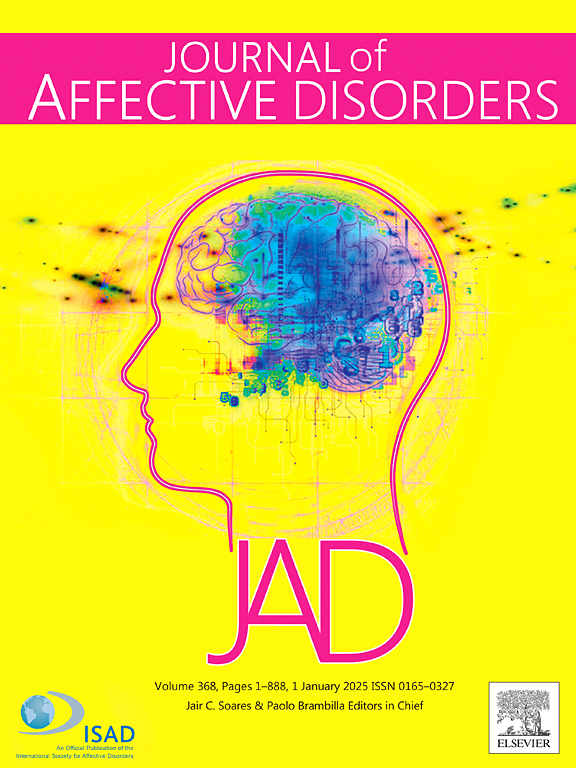活性安慰剂鼻腔喷雾剂对悲伤情绪影响的推广和增强。
IF 4.9
2区 医学
Q1 CLINICAL NEUROLOGY
引用次数: 0
摘要
导言:安慰剂效应,即在进行惰性治疗时产生的心理生物学反应:安慰剂效应,即通过实施惰性治疗而产生的心理生物学反应,会影响疼痛感知和情绪调节等多个领域。积极的框架可能会增强这种效应。本研究测试了积极安慰剂(模仿药物副作用以提高治疗可信度)对两种不同的悲伤诱导情境的影响是否具有普遍性,以及积极的副作用框架是否会增强这种效应:96名健康参与者被随机分配到三组中的一组:方法:96 名健康参与者被随机分配到三组中的一组:安慰剂+积极构思组(PPF)、安慰剂+标准信息组(PSI)或无治疗对照组(NTC)。参与者在现场实验过程中接受悲伤诱导方案,并在六小时后在家接受 20 分钟的在线随访。主要结果是自我报告的悲伤情绪,次要结果是自我报告的副作用:结果:在实验过程中服用安慰剂后,PPF 组和 PSI 组的悲伤情绪都比 NTC 组明显降低(p 局限性:自我报告的测量方法存在主观偏差。样本仅限于健康志愿者限制了其普遍性。六小时的时间可能无法捕捉到与临床相关的长期效应:结论:活性安慰剂鼻腔喷雾剂能有效减少悲伤情绪,在不同的情境下,效果可持续六小时。积极的框架并没有增强副作用的耐受性,但可能有助于在后续治疗中保持疗效。需要在临床人群中开展进一步研究,并探索长期效果。本文章由计算机程序翻译,如有差异,请以英文原文为准。
Generalization and enhancement of the effects of an active placebo nasal spray on sadness
Introduction
The placebo effect, i.e., the psychobiological response arising from administering an inert treatment, influences various domains, such as pain perception and emotional regulation. Positive framing might enhance this effect. This study tested whether the effect of an active placebo (mimicking drug side effects to enhance treatment credibility) on is generalized between two different contexts of sadness induction and if positive framing of side effects enhances this effect.
Methods
Ninety-six healthy participants were randomly assigned to one of three groups: Placebo+positive framing (PPF), Placebo+standard information (PSI), or no treatment control (NTC). Participants underwent a sadness induction protocol during an in-person lab session and a 20-min online follow-up at home six hours later. Primary outcome was self-reported sadness, secondary outcome was self-reported side effects.
Results
Both the PPF and PSI groups showed a significant decrease in sadness compared to the NTC group after placebo administration during the lab session (p < 0.001) and at follow-up (p < 0.05). At follow-up, only the PPF group did not experience a significant increase in sadness. Positive framing did not improve side effect tolerability.
Limitations
Self-reported measures introduce subjective bias. The sample restriction to healthy volunteers limits generalizability. The six-hour period may not capture clinically relevant long-term effects.
Conclusions
The active placebo nasal spray effectively reduced sadness, with effects persisting for six hours and across different contexts. Positive framing did not enhance side effect tolerability but may have helped maintain effectiveness at follow-up. Further research is needed in clinical populations and to explore long-term effects.
求助全文
通过发布文献求助,成功后即可免费获取论文全文。
去求助
来源期刊

Journal of affective disorders
医学-精神病学
CiteScore
10.90
自引率
6.10%
发文量
1319
审稿时长
9.3 weeks
期刊介绍:
The Journal of Affective Disorders publishes papers concerned with affective disorders in the widest sense: depression, mania, mood spectrum, emotions and personality, anxiety and stress. It is interdisciplinary and aims to bring together different approaches for a diverse readership. Top quality papers will be accepted dealing with any aspect of affective disorders, including neuroimaging, cognitive neurosciences, genetics, molecular biology, experimental and clinical neurosciences, pharmacology, neuroimmunoendocrinology, intervention and treatment trials.
 求助内容:
求助内容: 应助结果提醒方式:
应助结果提醒方式:


